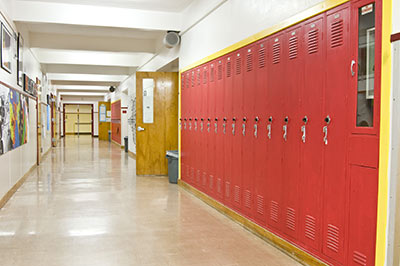Publications from EPA on Indoor Air Quality
Tag: Mold
Walkthrough: Four Schools Making a Difference
Indoor Air Quality: Ventilation Basics
Managing Asthma: A Guide for Schools
U.S. Department of Health and Human Services, 2014.
ASTHMA IS COMMON AMONG STUDENTS
Approximately 7 million children younger than 18 years of age in the United States have asthma.1
In a classroom of 30 students, about 3 currently have asthma.2 This rate may be higher in densely populated communities or among certain population groups. For instance, among African American children, 1 in 6 has asthma, an increase of nearly 50 percent from 2001 to 2009.3 Among Puerto Rican children, 1 in 5 has asthma, more than double the rate among Hispanic children overall.4 Additionally, there may be students who have asthma but have not been diagnosed.
ASTHMA IS A LEADING CAUSE OF SCHOOL ABSENTEEISM
Studies have shown that many students who have asthma miss school because of their disease. Asthma can lead to absenteeism for a variety
of reasons, such as symptoms, doctor visits, hospitalizations, the need to avoid environmental triggers at school, and sleep deprivation due to nighttime asthma attacks.5 Nearly half of students who have asthma miss at least one day of school each year because of their disease.6 In 2008, on average, students missed 4 days of school because of asthma.7
- Akinbami LJ, Moorman JE, Bailey C, Zahran HS, King M, Johnson CA,
Liu X. Trends in asthma prevalence, health care use, and mortality in the United States, 2001–2010. NCHS Data Brief No. 94. Hyattsville, MD: CDC; 2012. - CDC. Asthma and Schools [online]. Available from www.cdc.gov/HealthyYouth/asthma. Accessed July 1, 2014.
- CDC. Vital Signs: Asthma in the U.S. May 2011. Available from www.cdc.gov/vitalsigns/Asthma. Accessed July 1, 2014.
- National Health Interview Survey, National Center for Health Statistics, CDC. National Health Interview Survey, 2010. Table 4-1. Available from www.cdc.gov/asthma/nhis/2010/table4-1.htm. Accessed July 1, 2014.
- Basch CE. Asthma and the achievement gap among urban minority youth.
J School Health 2011;81(10):606-13. Available from http://onlinelibrary.wiley. com/doi/10.1111/j.1746-1561.2011.00634.x/full. Accessed September 9, 2014. - CDC. Asthma’s Impact on the Nation. May 8, 2012. Available from www.cdc.gov/asthma/impacts_nation/asthmafactsheet.pdf. Accessed July 1, 2014.
- CDC. Vital Signs: Asthma in the U.S. May 2011. Available from www.cdc.gov/vitalsigns/Asthma. Accessed July 1, 2014.
- Cohen DE. Asthma and school functioning. Health Reports 2010;21(4). Available from www.statcan.gc.ca/pub/82-003-x/2010004/article/ 11363-eng.pdf. Accessed July 1, 2014.
UNCONTROLLED ASTHMA CAN LEAD TO DECREASED ACADEMIC PERFORMANCE
When compared with students who do not have
a chronic condition, students who have asthma have decreased academic performance, according to standardized test scores and parental reports. More severe asthma is associated with poorer performance.8,9 Lower readiness scores were
found among kindergarteners who have asthma10; and entering school with asthma was found to be linked with lower reading scores after the first year.11 Effective management of asthma can eliminate potential challenges and obstacles to effective learning and academic success.12
ASTHMA CAN BE CONTROLLED— AND SCHOOLS CAN HELP
Through the use of well-coordinated asthma management programs, schools can play an effective role in helping students keep their asthma under control. Learn what your school can do to provide quality care for students who have asthma; be prepared to handle asthma emergencies; create an environment with fewer asthma triggers; and promote education and partnerships that support good asthma control.
Indoor Air Quality Tools for Schools Coordinator’s Guide A Guide to Implementing an IAQ Program
EPA, 2009.
The U.S. Environmental Protection Agency (EPA) created the Indoor Air Quality Tools for Schools (IAQ Tools for Schools) Program to help schools assess and improve indoor air quality (IAQ). IAQ is becoming an increasingly important issue in our nation’s schools. Approximately 20 percent of the U.S. population—nearly 56 million people—spend their days inside elementary and secondary schools. Good IAQ assists schools with their core mission—educating children. The background information and activities in this voluntary program are directed toward existing schools in the kindergarten through twelfth grade range, but colleges, universities, preschool, and day-care centers could benefit by applying the principles and activities presented.
HEALTHY CLEANING & ASTHMA-SAFER SCHOOLS A HOW-TO GUIDE
California Department of Public Health, 2014.
Asthma Environmental Intervention Guide for School-Based Health Centers
Regional Asthma Management & Prevention (RAMP) & California School-Based Health Alliance, 2015.
Asthma is a chronic inflammatory disease of the airways characterized by recurrent episodes of wheezing, shortness of breath, and coughing. Asthma symptoms are triggered by a variety of environmental factors: allergens like pollens and cockroaches or irritants like tobacco smoke and air pollution. These environmental asthma triggers cause inflammation, obstruction, and constriction of the lungs’ airways making it difficult—and sometimes impossible—to breathe. Reducing or eliminating exposure to these triggers can improve a patient’s ability to manage their asthma symptoms.
Although there is a broad array of evidence-based interventions to address asthma triggers, many people with asthma continue to be exposed to the factors that make their asthma worse. School-based health centers (SBHCs) are uniquely positioned to address this gap in order to help children breathe easier. While many SBHCs across the country are already playing a key role in helping students manage their asthma by providing quality clinical care and education, there is an opportunity for SBHCs to also be leaders in managing the environmental factors that make asthma worse. This guide describes the types of interventions that SBHC staff can initiate or support to reduce exposure to environmental asthma triggers.
The Indoor Air Quality Tools for Schools Approach: Providing a Framework for Success
EPA, 2015.
EPA’s IAQ Tools for Schools guidance has been implemented successfully in tens of thousands of schools nationwide. The Framework for Effective School IAQ Management synthesizes the accumulated learning of more than 800 schools involved in a national survey of IAQ management practices; 200 applicants for IAQ Tools for Schools awards; and in- depth interviews, site visits and analysis of five faculty school districts. The Framework provides a common language
to describe the drivers of IAQ program success; detailed guidance on the proven strategies, organizational approaches, and leadership styles that are fundamental to program effectiveness; and a clear vision of the pathway to school IAQ excellence. Its highly flexible and adaptable structure allows any school, regardless of location, size, budget or condition, to use the Framework to launch, reinvigorate and sustain an effective IAQ management program.
The Framework: Key Drivers
The Six Key Drivers are the essential elements of effective and enduring IAQ management programs. Applying a cycle of continuous assessment, planning, action and evaluation, the Six Key Drivers work synergistically to deliver effective school IAQ management programs. The Six Key Drivers are:
- Organize for success;
- Communicate with everyone, all the time;
- Assess your environments continuously;
- Plan your short- and long-term activities;
- Act to address structural, institutional and behavioral issues, and
- Evaluate your results for continuous improvement.The Framework: Technical SolutionsThe Six Technical Solutions define the most common issues that schools need to address to effectively manage IAQ risks. When addressed systematically
and aggressively, an IAQ program that focuses on the Six Technical Solutions will deliver a healthier school environment. The Six Technical Solutions are grounded in the IAQ Tools for Schools Action Kit, the Center for Disease Control’s School Health Policies and Programs Study and the management practices of leading school IAQ programs.
Addressing Indoor Air Quality in School Energy Efficiency Upgrades
ENVIRONMENTAL LAW INSTITUTE, January 2016.
Energy efficiency continues to be an important component of federal, state, and local efforts to reduce greenhouse gas emissions. School facility upgrades that increase energy efficiency can help school districts advance their educational mission by reducing energy and other operating costs. Facility upgrades that protect and improve indoor air quality (IAQ) also support the core mission of schools by promoting staff and student health, productivity, and attendance. There is now broad recognition that it is possible to achieve both energy efficiency and indoor air quality goals as part of a school retrofit project. When undertaking energy efficiency and other facility upgrades, early consideration of IAQ issues can help schools avoid unintended, negative consequences and reap the twin benefits of energy savings and a healthier, more productive school environment.
State laws, regulations, and guidance can facilitate the integration of IAQ and energy efficiency goals. This report discusses three areas of potential policy development: state funding for school facility upgrades, energy savings performance contracting, and regulation of indoor pollutants during renovation. While these are not the only policy areas ripe for consideration, the examples described throughout the report reflect a variety of strategies for maximizing the health benefits of energy retrofits and other school facility upgrades.
School Facility Conditions and Student Academic Achievement
Glen I. Earthman, 2002. School building design features and components have been proven to have a measurable influence upon student learning. Among the influential features and components are those impacting temperature, lighting, acoustics and age. Researchers have found a negative influence upon student performance in buildings where deficiencies in any of these features exist.










